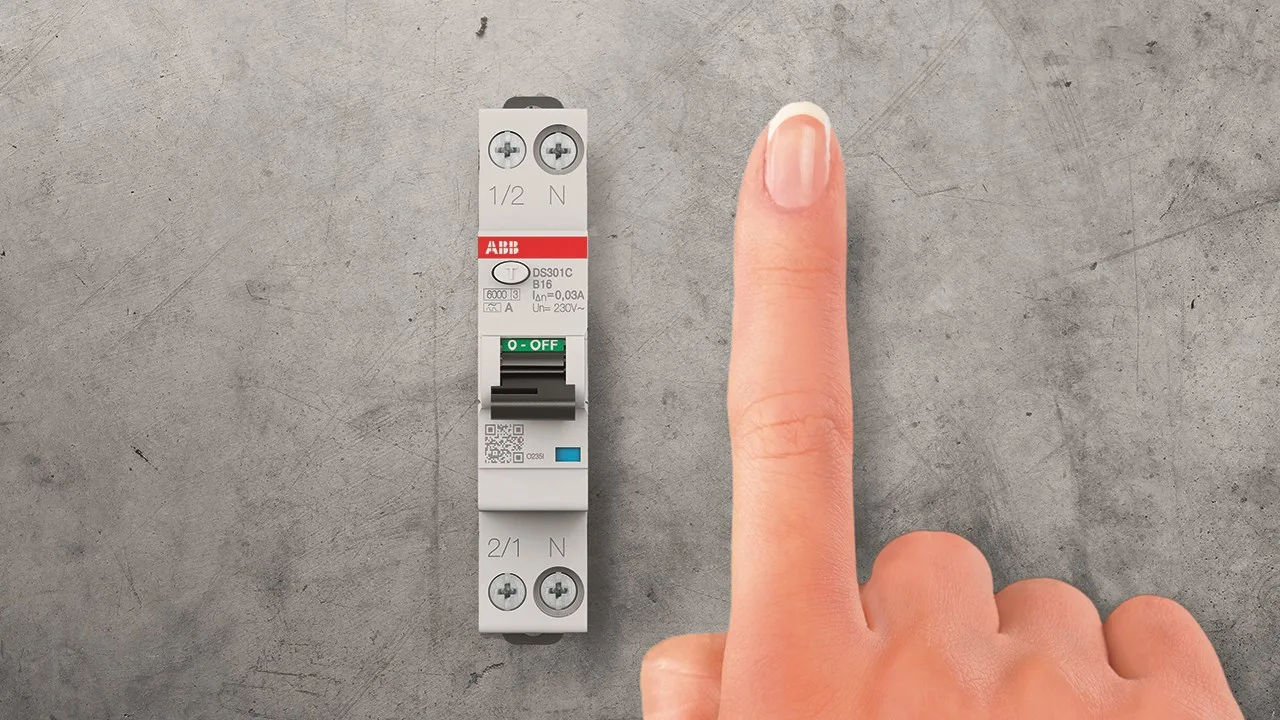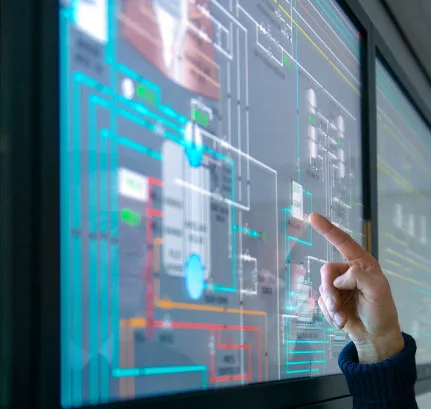


January 29th, 2024
Compact impact: ABB’s new DS301C compact circuit breaker
Combining the functions of multiple relays into one device, CPC reduces network complexity, thus providing the means to better manage substation protection. And, by offering CPC as a virtualized image, ABB enhances scalability and flexibility – a boon for time-critical control and protection applications.
Driven by the desire for more capillary control and increased safety, the number of branches in low-voltage electrical installations – and the quantity and type of circuit breaker found there – is undergoing profound change. This rapid evolution means more electrical devices must be accommodated into electrical panelboards. This poses a major miniaturization challenge to circuit-breaker manufacturers like ABB. The trend mostly concerns final distribution lines, usually hosting loads supplied by one phase and the neutral conductor.
This context explains the remarkable market acclaim for ABB’s newly released DS301C. The DS301C is an extremely compact, one-phase and neutral RCBO that combines protection against short-circuit, overload and earth fault – all in a single circuit breaker just one module wide, as opposed to the two-module width of current approaches. Crucially, the breaker is voltage-independent – ie, it works without an external power source.
Space savings through targeted specification
To allow space optimization, the electrical ratings of the DS301C have been precisely matched to the targeted applications – for example, residential, commercial, marine and railway installations. The DS301C is characterized by a rated current of up to 20 A, a more-than-respectable short-circuit capacity of 6 kA, and – for earth faults – the classic maximum residual current of 30 mA. The DS301C not only detects current leakages with sinusoidal waveforms but also the truncated or distorted waveforms associated with electronic appliances, such as LED lights, computers, etc. A compact product like the DS301C allows panels to be more compact, too – a benefit greatly appreciated when extending or retrofitting electrical installations in hospitals, boats, trains, etc.
Fast and easy installation
Speedy and straightforward installation was a cornerstone of the DS301C design philosophy in order to shorten installation time and make the process error-proof.
Either flexible cables or rigid busbars may be used to wire the circuit breaker. Additionally, the DS301C comes in versions compatible with ABB’s newly released fast wiring system, which allows product mixing on the same DIN rail. This system has the added advantage that the electrical feed-in connections that bring power from one DIN rail to the next in the vertical direction can be accomplished by the first circuit breaker in the line, requiring neither dedicated products nor specially shaped busbars that constrain the type and number of products that can be mounted.


January 22nd, 2024
How To Reduce Capital Expenses Up To 30% By Optimising Power Quality
By Eugene Quah, Country President, Malaysia at Schneider Electric and Ir. Gunasegaran Reddy, Managing Director, Perunding Shanu Sdn Bhd
Due to rapid urbanisation, buildings in Malaysia rely significantly on electricity to meet energy needs for homes and businesses. The need for cooling is also expected to increase, leading to more electricity usage in the future. On average, the demand is predicted to grow between 1.8% and 2.9% yearly in all scenarios as revealed by the International Renewable Energy Agency (IRENA). The demand for energy is also set to further escalate, driven by the current growth in generative AI technologies and similar tech trends.
When it comes to sustainability, we are encouraged to see the commitment by our government in lowering emissions while ensuring the growth of a low-carbon economy for the country, especially with the introduction of the National Energy Transition Roadmap (NETR). In line with these efforts, the building sector need to rise above to play its part too, because electricity will play a much larger energy consumption role in the future than it does today.
In the near future, buildings will not just consume power, but they will also produce, store, and share it. Due to the intermittent nature of renewables and effects of power conversion, managing power quality will be important. It requires a comprehensive approach that involves a combination of monitoring, preventive measures, as well as collaboration with expert partners and stakeholders. By implementing these strategies, businesses can minimise downtime, reduce equipment damage, and ensure a reliable and high-quality power supply.
What is the big deal with power quality?
Electric power quality is the degree to which the voltage, frequency, and waveform of a power supply system conform to established specifications. Good power quality can be defined as a steady supply voltage that stays within the prescribed range. It is useful to consider power quality as the compatibility between what comes out of an electric outlet and the load that is plugged into it.
Drawing from our experience, it’s observed that numerous companies in Malaysia often do not prioritise power quality, mainly because it is not directly factored into the determination and analysis of production output. Companies typically analyse downtime or immediate equipment failure after these events occur. Subsequently, they implement mitigation measures to justify production losses, establishing a correlation between the impact of power quality on production loss and the cost of investing in power quality mitigation measures.
While engineering and maintenance personnel display a heightened awareness of the importance in implementing power quality measures, the management and finance departments generally adopt a cautious “wait and see” approach toward power quality mitigation measures, based on our observations.
The impact of power quality issues cannot be underestimated. They stand as a significant cause of unscheduled downtime, equipment malfunctions, and costly damages. When power quality falters, be it due to interruptions, voltage dips, or harmonic pollution, the repercussions ripple through the business operations.
This is a matter of increasing concern for businesses and end-users, considering not only the frequency of such incidents but also the substantial financial impact. Did you know that 30% to 40% of all unscheduled downtime today can be traced back to power quality problems? About 50% of mission-critical power outages are attributable to power quality issues.
When we look at the cost, we found that companies spend on average MYR 70 billion annually on power quality issues and experience revenue loss of about MYR 600,000 when a facility is affected. To break this down further, the downtime costs to mission-critical facilities range between MYR 65,000 up to a staggering MYR 26 million an hour! That’s about 3% to 6% of the manufacturing sales money spent on correcting power quality problems.
How can we manage power quality more effectively?
Effective power quality management demands a comprehensive approach encompassing three vital elements: monitoring, taking preventive measures, and collaborating with expert partners and stakeholders.
Monitor: This marks the initial phase in designing and implementing power quality mitigation measures. It not only establishes a record of power quality issues but also compiles data on power usage for effective energy management.
Taking preventive measures: The second step requires companies to study the patterns of how the electricity is behaving and the unique characteristics of the electricity. Consider preventive measures ensuring immunity to voltage sags to safeguard against issues affecting major electronic loads and crucial production lines due to voltage drops. This is an ongoing process involving consistent monitoring, adopting enhancements, and improving power quality.
Collaborating with expert partners and stakeholders: They can provide valuable insights and support in optimising power quality solutions. This collaborative approach ensures a comprehensive strategy and the integration of expert knowledge to address potential challenges effectively.
By implementing these steps, companies can minimise downtime, reduce equipment damage, and ensure a reliable and high-quality power supply.
Harnessing the potential of power quality management
Investing in power quality solutions not only ensures high-quality power, leading to increased productivity but also provides a quick return on investment. Companies can reduce their capital expenses up to 30% when they optimise their electrical system, avoid oversizing, and limit redundant capacity. They can also reduce energy losses by up to 30% when they optimise their power consumption and reduce total process energy consumption by reducing CO2 emissions.
Good power factor can also lower power bills and reduce power losses in transformers and conductors. Companies can reduce utility billing penalties and lower operating expenses up to 10%.
One example comes from Schneider Electric’s customer in the Gulf region. We work with Kuwait’s Ministry of Electricity and Water that faced with fast-rising demand, a distribution network running at capacity, plus transformer and switchgear difficulties. As a solution, they used advanced power quality meters to remotely monitor each capacitor bank. Although rated for 50°C ambient temperature, outdoor capacitor banks are cooled to ensure uninterrupted performance even during the most severe temperatures.
As a result, they received an additional 15% to 20% kVA network capacity – and reduced transformer losses by approximately 20% to 25%. Today, their electricity tariffs are amongst the lowest in the world.
Energy Consumption Monitoring to meet Sustainability Goals
Achieving sustainability goals is contingent upon monitoring energy consumption. This not only serves the direct purpose of aligning with sustainable practices but also indirectly opens avenues for effective power quality monitoring.
The same monitoring devices used for tracking energy consumption can be leveraged to assess and enhance power quality. The commitment to sustainability goals not only streamlines monitoring processes but also contributes to the implementation of power quality mitigation measures. This is made possible by readily available data and records, which can be instrumental in preparing reports and proposals for company management.
These insights, in turn, guide the implementation of robust power quality mitigation measures, ensuring that companies operate in an energy-efficient and sustainable manner.


May 10th, 2023
Lorem Ipsum
Lorem ipsum dolor sit amet, consectetuer adipiscing elit, sed diam nonummy nibh euismod tincidunt ut laoreet dolore magna aliquam erat volutpat. Ut wisi enim ad minim veniam, quis nostrud exerci tation ullamcorper suscipit lobortis nisl ut aliquip ex ea commodo consequat. Duis autem vel eum iriure dolor in hendrerit in vulputate velit esse molestie consequat, vel


April 22nd, 2023
Lorem Ipsum
Lorem ipsum dolor sit amet, consectetuer adipiscing elit, sed diam nonummy nibh euismod tincidunt ut laoreet dolore magna aliquam erat volutpat. Ut wisi enim ad minim veniam, quis nostrud exerci tation ullamcorper suscipit lobortis nisl ut aliquip ex ea commodo consequat. Duis autem vel eum iriure dolor in hendrerit in vulputate velit esse molestie consequat, vel
